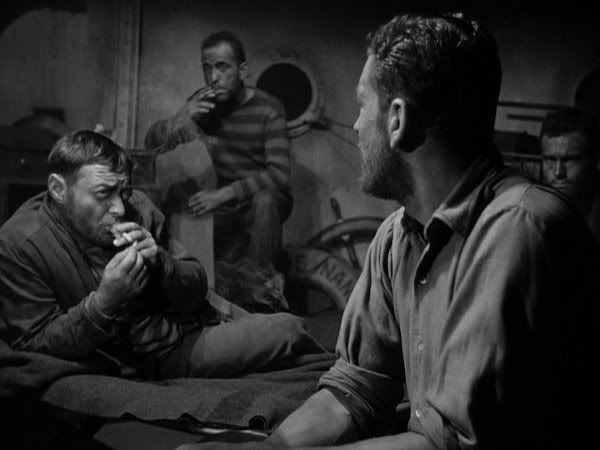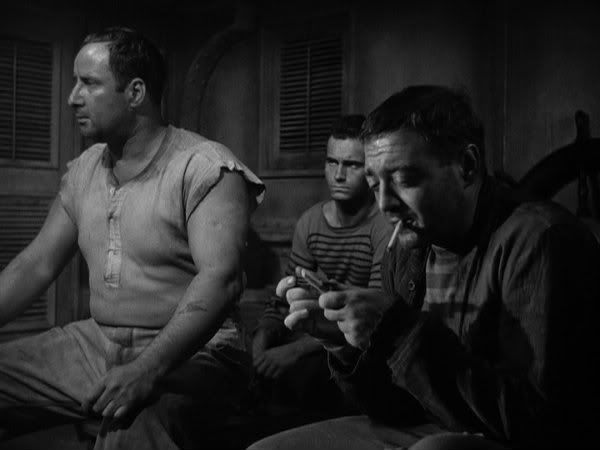While during production Casablanca was considered a disaster in the making, it did OK at the box office and is still remembered fondly by a few film buffs today. So it’s unsurprising that Warners decided to pimp that success with this rather similar venture, doing all they could to recreate the magic. Unsurprisingly, the film comes up rather short by that standard. It’s got some pretty good stuff in it, though.
Many, if not all, of the usual suspects had been rounded up for this follow-up. Director Michael Curtiz helms, while Humphrey Bogart stars and is supported by Casablanca vets Claude Rains, Sidney Greenstreet and, of course, Peter Lorre. There’s even a wedding reception scene featuring a strolling female singer with a guitar; it’s indeed the same strolling female singer with a guitar who worked at Rick’s in Casablanca.
There’s a lot of thematic and stylistic lifting as well. The La Marseillaise is used heavily in the score, the plot revolves around free Frenchman straining to fight the Bosch, and there are many plot elements and even the occasional shot lifted from the earlier film. One character is an aged convict on French Guiana. His sentence is done, but he’s not allowed to leave the island and return to his beloved France. This obviously recalls the trapped refugees stuck in Casablanca.*
[*After the film I watched the trailer, included on the DVD, and it unsurprisingly beat the Casablanca drum pretty heavily, even featuring footage from that film.]
Hmm, this shot reminds me of something. (Claude Rains in French uniform on the right.)
The biggest problem is that the narrative is extremely disjointed. The film is laden with flashblacks; I’m not exaggerating when I say that at one point we’re watching a flashback, in a flashback, in another flashback, in yet another flashback. (At this point the movie was in serious danger of become self-parodying.) These layers of story are not equally compelling, and the two most interesting layers are in the middle, which throws the film off-kilter.
While actual Nazis are sparse on the ground here–there’s one air attack by a German plane, although it’s pretty sweet–we again get some Casablanca-esque Vichy French quislings (the most prominent of which is played by Greenstreet). Bogart again is a now-embittered, cynical former freedom fighter who now vows to stay out of the fighting and solely watch out for number one, and who had had a life-altering pre-war romance in France seen in an extended flashback.
The object of his affections here, French actress Michele Morgan (the only major cast member who is actually French; Bogart with his terse American accent is the least convincing ‘Frenchman’ of the bunch) is capable and certainly pretty. However, it’s patently a thankless task to step in for film goddess Ingrid Bergman, not to mention trying to replicate what is arguably the single greatest cinema romance of all time.
The cast is uniformly good; this was clearly a prestige picture. Buffs will note a young uncredited Hans Conried playing a slimy ship’s officer, while one of Bogart’s crew, a big French farmer called Petit (some jokes are universal, I guess) is played by George Tobias, who would go on to become a familiar comic character actor. He’s probably best remembered now for playing Abner Kravitz, the long-suffering husband of the nosy Gladys Kravitz, on Bewitched.
Curtiz was an able director, and the cinematography is top-notch. Some of the most hypnotic scenes are those where several men are conversing in some confined space or other; Curtiz knows exactly how to position the actors for maximum effect, and the often noir-ish lighting simply drenches portions of the film with atmosphere.
Modern audiences might at times find the film unbearably schmaltzy, but the studios were making movies to help the war effort, and there wasn’t much place for moral shadings and concerns of personal fulfillment. Still, it’s quite a difference in attitude from the stuff we get today.
Like many film from this era and earlier, there’s a lot of model work for ships, trains, planes and even cars and landscapes. As a kid I always wondered why Toho films would cut to a model plane in flight rather than use stock footage of a real one, but American and British movies used to do the same thing. The model work doesn’t always completely fool the eye, but the sheer technical competence and skilled craftmenship of it remains endlessly engaging.
To my delight Lorre has a fairly substantial part in this one. It’s not as iconic as his roles in Casablanca or Maltese Falcon, but then, those were iconic movies. Still, he gets a fair amount of screen time here, more than I feared. And it’s nice to see Lorre playing what is basically a good guy character. I thought he’d betray his comrades or do something dodgy at some point, but he never does. Of course, it would have been a waste to use him like that all the time, but it’s a nice change of pace nonetheless.
Like many savvy directors, Curtiz gets that Lorre had major screen presence, and so the actor is prominently placed in many shots as a background or foreground element. And in those cases when it wasn’t Curtiz’ idea, it was undoubtedly Lorre’s. The actor was an expert at coming up with bits of audience distracting business during other actor’s scenes, such as futzing with a cigarette or a prop of some kind. I laughed out loud in one scene here when Lorre plops himself down and begins whittling away at a small piece of wood.


Well worth a look for general old movie buffs and especially for those who like World War II movies.
